Consumer Electronics Show 2005: AT's Coverage
by Anand Lal Shimpi on January 10, 2005 3:49 AM EST- Posted in
- Trade Shows
1080p DLPs Coming in April
Texas Instruments was quite eager to showcase all of the DLP based rear projection TVs that use their DLP chips.

Panasonic's 720p DLP
The most exciting thing at the TI booth however were the handful of displays that used TI's new xHD3 DLP - their first 1080p (1920 x 1080 progressive) DLP solution.

A 1080p image
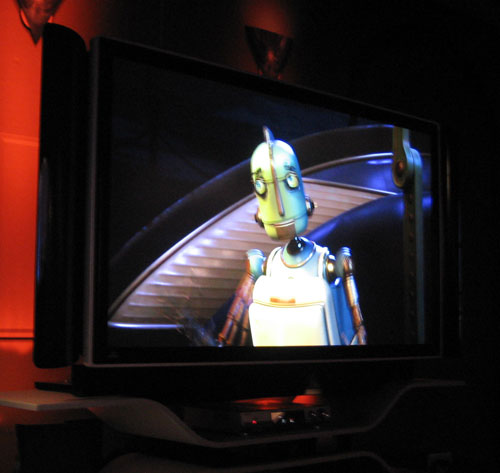
A 70" 1080p DLP
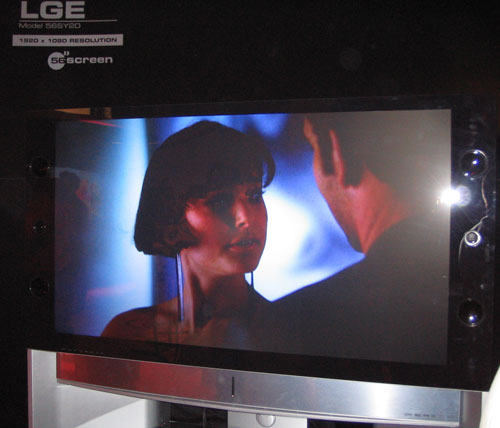
LGE's 1080p display
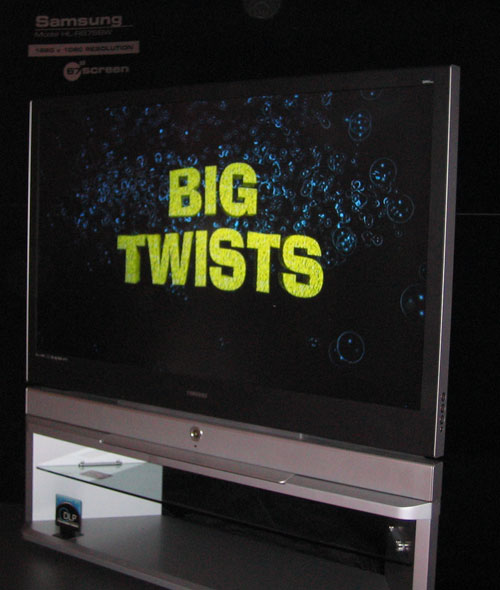
Samsung's 67" 1080p DLP priced at over $6000 and available in April
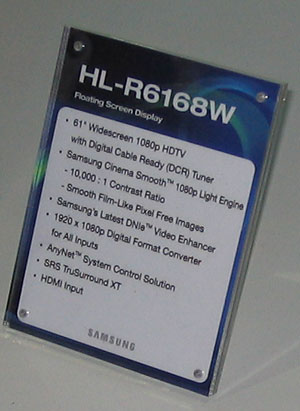
Samsung will also offer a 61" 1080p DLP
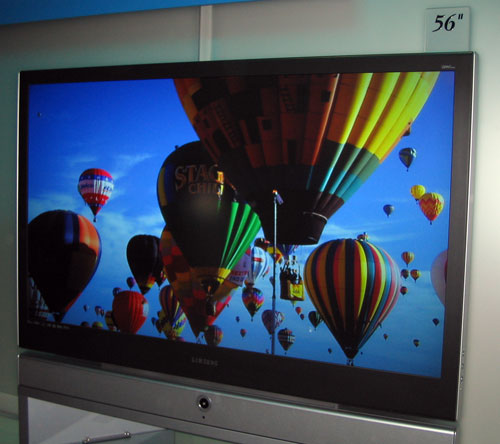
Samsung's 56" 1080p DLP also due out in April
TI also gave us a rundown of their current DLP lineup to clear up any confusion there may be over the cost/features of various TI solutions in DLPs today:
HD2 - TI's older DLP measures 0.8" diagonally and is a rectangular grid 720p DLP.
HD2+ - A higher contrast version of the HD2. The higher contrast was made possible through process improvements allowing for closer positioning of the individual mirrors, smaller mirrors and darker coatings to help absorb unwanted light inside the DLP.
HD3 - A 0.55" diagonal die not on a rectangular grid using half the mirrors of the HD2/HD2+ but still a 720p solution. Using mirrors that can move and stabilize at twice the speed of the HD2+ solution, TI was able to use each mirror for two pixels in the HD3 chip by shifting each individual mirror very slightly and very quickly to paint two pixels (think of it as a serial DDR approach to DLPs). The benefit of using half the mirrors is that it drives down the size of the DLP (0.55" vs. 0.8") and thus reduces the price of the TVs. The DLP also somewhat overlaps the two pixels it paints using a single mirror to get rid of pixelization, to provide for a smoother, more film-like image (which some may or may not prefer). TI calls this 2 pixels per mirror technology their Smooth Picture Technology, so whenever you see that phrase used it means that the TI DLP is only using half the necessary mirrors and using each mirror to drive 2 pixels.
xHD3 - A larger chip with a 0.85" die, the xHD3 is basically a HD3 that does 1080p. It also features Smooth Picture Technology.
Samsung displays based on the xHD3 DLP will be out in April, and available in sizes ranging from 56" up to 67".










48 Comments
View All Comments
dderidex - Monday, January 10, 2005 - link
About that SN25P....nice Envy24 chip on it - but do we know anything about the DAC used?24/192 internal precision is useless if they pair it with a 16/48 DAC. If their was a Wolfson chip on that motherboard by the Envy24 chip...I would be *drooling*.
Reflex - Monday, January 10, 2005 - link
#36: I am not debating that. I am saying that you need to pay attention to his statement about 'a way that you won't expect'. For one, it won't be a nVidia developed solution. That I can guarantee you since there is NO DESIGN TEAM anymore. But you can choose to believe what you wish I suppose....shinotenshi - Monday, January 10, 2005 - link
SAN JOSE — Here at NVIDIA's Editor's Day event today, NVIDIA CEO Jen-Hsun Huang addressed questions about the company's plans for a possible second spin of its popular but ill-fated SoundStorm audio solution. Apparently, a reprise of SoundStorm will happen. Huang told the assembled press types, "We're gonna build SoundStorm 2. It's gonna be awesome." He was less clear on what form the next SoundStorm would take, saying that NVIDIA was still trying to figure out how to deliver SoundStorm as a product. Huang said, cryptically, that the new SoundStorm "will come in a way that you won't expectshabby - Monday, January 10, 2005 - link
14: the way our living room is arranged we needed a display that allowed viewing from an angle and needed to be thin, and this is where the dlp fell flat on its face. It was too dark and too thick, at least compared to a plasma.While plasma's do wear out over time, thraxes just proved that it takes a long long time.
Reflex - Monday, January 10, 2005 - link
SoundStorm is completely dead. The group is disbanded and its members have found jobs in other parts of the company. This is a fact.Sound in nVidia's chipset solutions is not dead, however. From what I have heard though its just a license of Intel's Azalia spec. In other words: No different than the integrated sound that you get on any Intel chipset board nowadays.
The SoundStorm solution that you all know from the NF/NF2 days is completely gone however, and it will NOT be making a comeback.
shinotenshi - Monday, January 10, 2005 - link
Well As i said, as being part of chipset its dead. but nvidia knows it can make a killing makeing add in sound boards. creative makes weak products let get real. The orginal soundstorm needed too much bandwidth to be done on pci. with PCI-E they have enough bandwidth to produce the card. Nvidia will be able to fund SS2 development becuase of its deal with the Ps3. The PS3 will need a high end sound chip because im sure sony is going to use it as means of spreading blu-ray introduction.bob661 - Monday, January 10, 2005 - link
I think the CEO of Nvidia is just trying to keep customers. He would lose a few by announcing that SS is totally dead. I would string you guys along until it didn't make a difference whether you bailed or not.bob661 - Monday, January 10, 2005 - link
The Inq isn't lying. They are reporting what's been told to them. That's they're job. Sometimes it's bum info.knitecrow - Monday, January 10, 2005 - link
On the soundstorm issue, I personally wouldn't believe AMD, Intel, Nvidia, or ATI... they have been known to lie when it suits their interests.**cough** 6800GT/ultra hardware mpeg2/WMV decoding **cough**
There are conflicting reports to be sure, but I am more likey to believe those from close partners. I am sure the next soundstorm is going to be an intel azilla rehash to appease the masses.
shinotenshi - Monday, January 10, 2005 - link
Soundstorm is not dead, the chairman of nvidia confirm this himself. however i think its dead as far as being apart of a chipset. the chairman remarked that it would return in a suprising form.this has to the belief that either it will return as a seperate chip sutitable for add in sound boards, or interagrated in graphics cards. my bet is that it will return as a PCI-e card capable of encoding some the advance audio codecs that are apart of the blu-ray spec. I don't think it was a coincidence that the chairman of nvidia made the announcement shortly after it was revealed that nvidia would be doing the PS3's GPU.